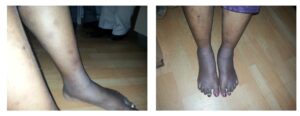
Image type: Hyperpigmentation with nodosum rashes
Body site: Legs
Description: Hyperpigmentation is a condition that causes the skin to darken, occurring in small patches or covering large areas, and sometimes affecting the entire body. While usually harmless, it can indicate an underlying medical condition. Erythema nodosum, a type of skin inflammation, presents as painful, reddish lumps or nodules below the knees, ranging in size. These nodules may inflame periodically before shrinking and leaving a bruised appearance.
Cause: One common cause is the overproduction of melanin by melanocytes. Various factors can disrupt melanin production, including certain medications like chemotherapy drugs, hormonal changes during pregnancy, and endocrine diseases such as Addison’s disease, affecting hormone production. Excessive sun exposure can also stimulate melanin production, leading to hyperpigmentation patches. Additionally, pregnancy increases the risk of hyperpigmentation. Nodosum rash, often non-pruritic, appears on the lower legs and is linked to connective tissue diseases, viral infections, and drug allergies.
Treatment: Erythema nodosum typically resolves in three to six weeks, sometimes leaving a temporary bruised appearance or chronic skin indentation. Chronic erythema nodosum, recurring over weeks to months, may persist for years with or without an underlying disease.
Treatment for hyperpigmentation and nodosum rash may involve the following:
- Creams containing ingredients such as hydroquinone or retinoids may be used to lighten hyperpigmented areas.
- Pain relief medications or topical treatments can help alleviate discomfort associated with nodosum rash.
- Treating underlying medical conditions contributing to hyperpigmentation or nodosum rash, such as connective tissue diseases or infections, is essential.
- Regular use of sunscreen and protective clothing can prevent further darkening of the skin due to sun exposure.
- In severe or chronic cases, laser therapy or immunosuppressive medications may be prescribed to manage symptoms and prevent recurrence.
